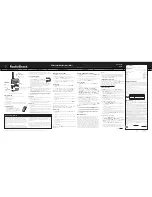
Theory of Operation
Preliminary
10
3.3 Initialization Sequence
When operating in the three Transparent Serial Interface Modes, the initilization sequence is
managed by the AeroComm protocol. In-Range commands are not issued and there is no acknowledge from
the radio on data delivery unless the OEM protocol has built-in acknowledgement.
When operating in the API Serial Interface Mode 03, the following initialization sequence
occurs
. During the power up sequence or upon a
Reset*
command, the Clear to Send (CTS) line is set high
(5V TTL logic levels). While CTS is high, initialization occurs, and when finished, CTS is put low
indicating successful initialization is complete.
Note: At this point, the only command that can not be issued is the Send_data* command. This
command can only be issued after the RF_enable* and In_range* commands have been issued.
Before data communications can begin, a client radio needs to be authenticated. The client host
must issue an
RF_enable*
command to activate the client radio and receive an acknowledgement from the
client radio. The server radio transmits a beacon containing it’s IEEE 802.3 address. Once the client radio
has been activated by use of the
RF_enable*
command, it will receive the server radio IEEE 802.3 address
once it is in range. Upon receiving the IEEE 802.3 server radio address, the client radio will issue an
In_range*
command to the Client Host containing the IEEE 802.3 server radio address.
The client host must receive the
In_range*
command from the client radio before the
Send_data*
command is invoked. Broadcast mode, as defined by IEEE 802.3, is supported and can be used to send
data to all radios that are within range but its use should be limited because reception of the message is not
guaranteed.
When the last bit of data is transferred from the Host to the radio, the Host must wait for the CTS
line to transition high (meaning that the radio has found the end of the data packet) and then transition back
low (meaning that the radio is ready for the next command).
Clear To Send minimum delay of 40
µµµµ
s between (1) and (2) after end of data packet
Note: All serial data must be transmitted LSB first.
Note: These radios are designed to be single threaded, meaning that for every command issued, there
is a reply command that signifies the completion of the command issued. There can be no
interleaving of commands.
CTS
from
Radio
Delay for reply command
*Note:
If level translators are
used the CTS signal will be
inverted coming from the radio.
TXD
LSB First
From Host
Command
Length
Checksum
Data
(1)
(2)











































